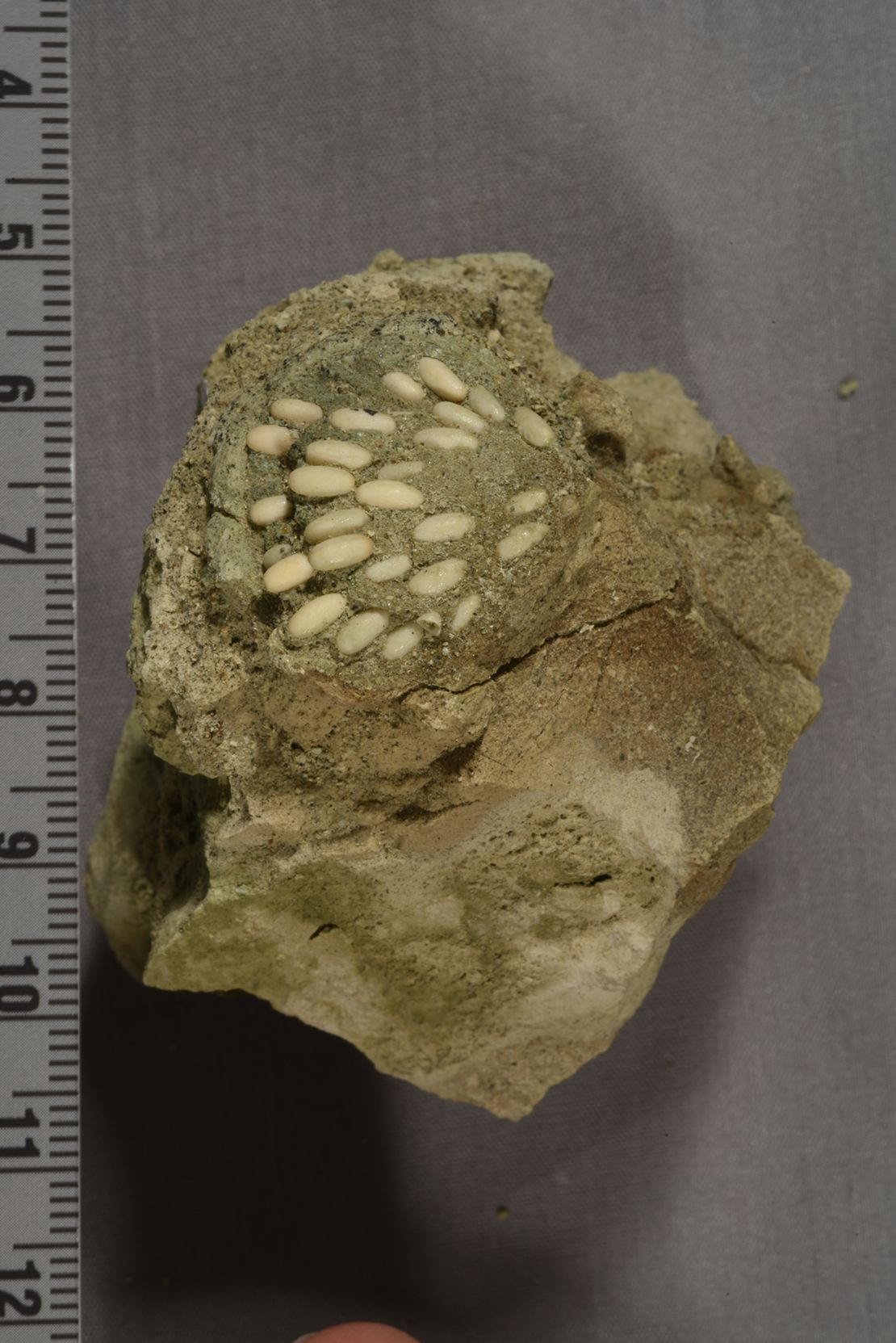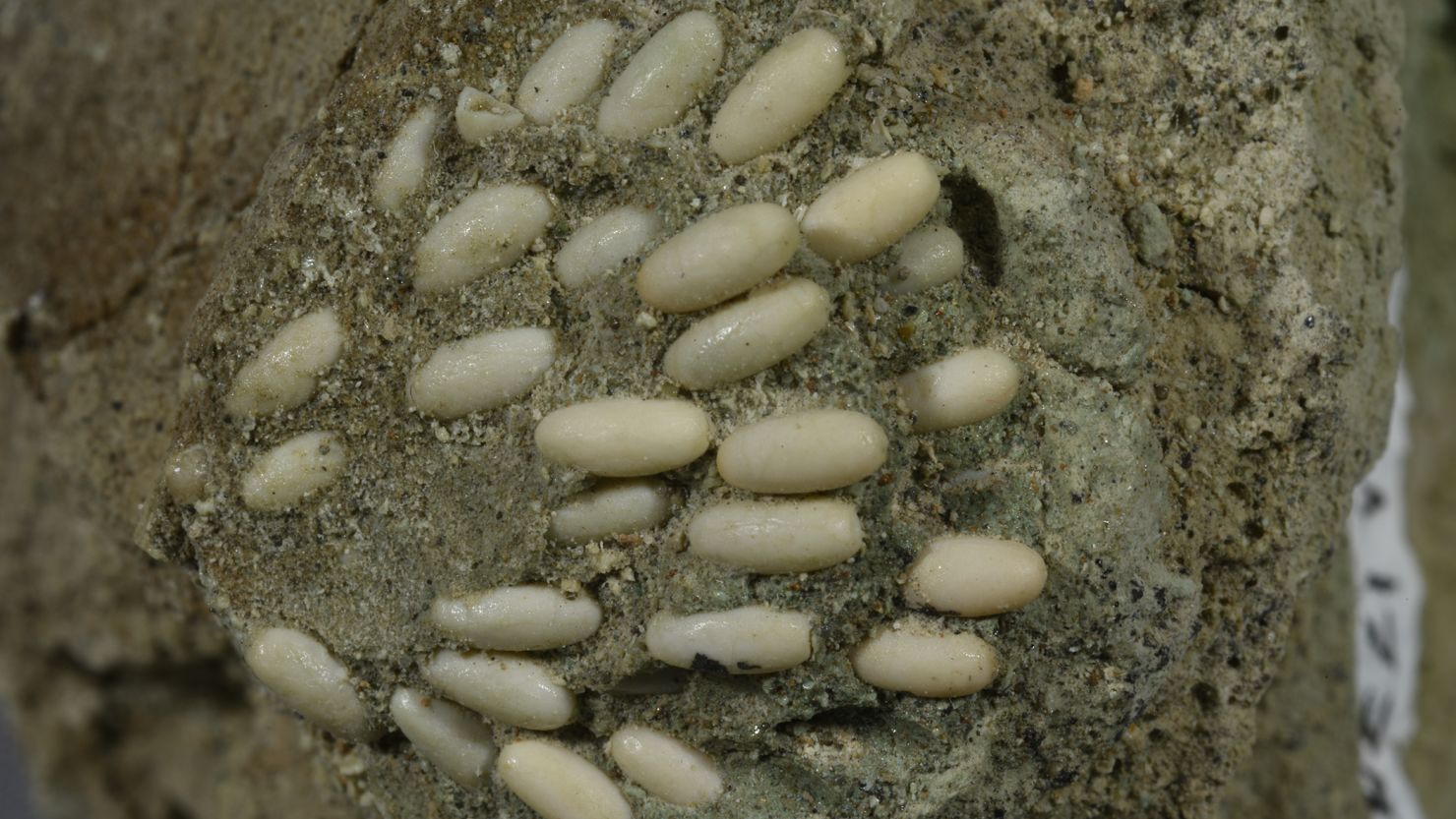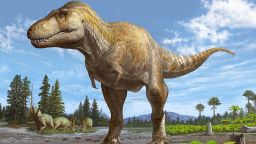Sign up for CNN’s Wonder Theory science newsletter. Explore the universe with news on fascinating discoveries, scientific advancements and more.
In an ancient temperate forest in what is now Oregon, an insect dug deep into a sandy bank near a creek. There, in a damp burrow, she laid dozens of oblong eggs, about 50 in all. Despite her careful work building this underground nursery, none of the eggs would ever hatch. Instead, the eggs, enclosed within a pod, fossilized into a stony, mineralized mass. And now, 29 million years later, they stand as a record of insect reproduction that could be unlike anything paleontologists had seen before.
Recently, micro-CT scans of the egg case revealed not only that it was millions of years old, but also that it was most likely made by a grasshopper. The eggs and overall nest construction closely resemble the eggs and pods of modern grasshopper species. This newly documented knowledge paints a clearer picture of that ancient ecosystem, confirming that grasshoppers were present and thriving there — and that some types of grasshoppers were burying their eggs underground.
Insect eggs are extremely rare in the fossil record, and intact egg cases are even rarer. This is likely the only fossilized grasshopper egg pod on record, and it offers a view of their reproduction dating back to the Oligocene Epoch (33.9 million to 23 million years ago), researchers reported Monday in the journal Parks Stewardship Forum.
“This work is exciting because such exceptional preservation provides unique insights to one of the least understood life stages of insects, particularly in the geologic past,” lead study author Jaemin Lee, an evolutionary ecologist and doctoral student at the University of California, Berkeley, told CNN in an email.
Undisturbed fossilization
What makes this fossil even more remarkable is that it was found in a habitat that typically isn’t kind to fossilization, said study coauthor Dr. Nick Famoso, a paleontology program manager and museum curator at John Day Fossil Beds National Monument. The site, located in Mitchell, Oregon, is under the management of the National Parks Service.
Delicate fossils such as this specimen are usually preserved in lake deposits alongside plant matter. Such places tend to be anoxic, or oxygen-poor, and relatively static, Famoso explained. There, fossils can form in peace, untouched by currents or bacteria. But millions of years ago, a river or stream ran through this location. Nevertheless, conditions surrounding this egg pod were just right for it to stay buried and fossilize undisturbed in nearly perfect condition, despite the dynamic environment of flowing water nearby, Famoso said.
The eggs in this fossil stand out for their preservation, “both individually and in clusters,” paleobiologist Dr. Ricardo Pérez-de la Fuente, deputy head of research at the University of Oxford’s Museum of Natural History in the United Kingdom, said in an email.
“They are the first to be recognized as belonging to orthopterans — grasshoppers and their kin — in the fossil record, which is noteworthy,” said Pérez-de la Fuente, who was not involved in the research.
“The work also represents an important step towards formalizing the description of immature stages of insects, more particularly those of eggs,” Pérez-de la Fuente said. This branch of science, known as ootaxonomy, “can provide paramount data on the evolution, behavior and ecology of insects in deep time, but which tend to be neglected in paleontological studies.” What’s more, he added, the pod and eggs may offer clues about the environment where they fossilized.
The eggs had an unusual curvature
Christopher Schierup, a collection manager for the National Parks Service, discovered the egg case in the fossil beds in July 2012. Schierup was conducting a routine visual survey of the site when he spotted the object, which was embedded in a chunk of rock that had rolled down a hill, Famoso recalled.
“It did not require any tool work to get it out of the ground,” he said. Schierup swaddled the object in toilet paper, “and carefully returned to the visitor center where our lab is located,” Famoso added.

Based on surface analysis of the fossil, the researchers initially thought they had found a cluster of ant eggs. But Famoso was skeptical, as their curvature differed from the curves of ant eggs and pupae. His suspicions were corroborated by Lee, who first saw the object in 2022 during a visit to the John Day Fossil Beds. They brought the specimen to the University of Oregon’s Knight Campus in Eugene, where micro-CT scans were conducted by study coauthor Angela Lin, director of the X-ray Imaging Research Core Facility.
“That’s when we discovered that there was this protein layer that was holding everything together,” Famoso said. This wasn’t just a cluster of eggs — it was a type of subterranean egg pod called an ootheca, with the eggs cradled by a protective layer that had mineralized into a stony rind.
“Belowground egg pods are currently produced by only two groups of insects,” Lee said. These are grasshoppers (order Orthoptera, suborder Caelifera) and heelwalkers (order Mantophasmatodea).
Radial arrangement
On the surface, 28 ellipsoid eggs were visible, each measuring no more than 0.18 inches (4.65 millimeters) long and 0.07 inches (1.84 millimeters) wide (this is comparable to the eggs of modern grasshoppers, though egg size can vary depending on the species). Scans revealed over two dozen more eggs buried in the matrix in four to five layers, arranged in a radial pattern. Some of the eggs were hollow, while others had filled with sediment, the study authors reported.
“The mineralization that we were able to see in each of the eggs made it very clear that that was a fossilization structure,” Famoso said.
Because fossil insect eggs are so scarce, there weren’t many specimens available for comparison. So Lee consulted a global insect egg database, containing more than 6,700 living species, to identify the eggs in the fossil pod.
“I compared the defining egg features, including size, length to width ratio, and curvature of the individual eggs to those of the living ones,” he said. “Such large, elliptically curved eggs in a large clutch size (~50 eggs in total) are unknown from any other living groups of insects other than grasshoppers and locusts.”
This unusual find provides a never-before-seen glimpse of reproduction in the ancient relatives of modern grasshoppers. The virtually pristine specimen also speaks to the level of preservation in the national park site’s fossil beds, Famoso added.
“Just being able to see that internal structure and really properly describe what these things look like — that was something that was really exciting for us,” Famoso said. “There just isn’t anything else like this in the fossil record anywhere that we know of.”
Mindy Weisberger is a science writer and media producer whose work has appeared in Live Science, Scientific American and How It Works magazine.







